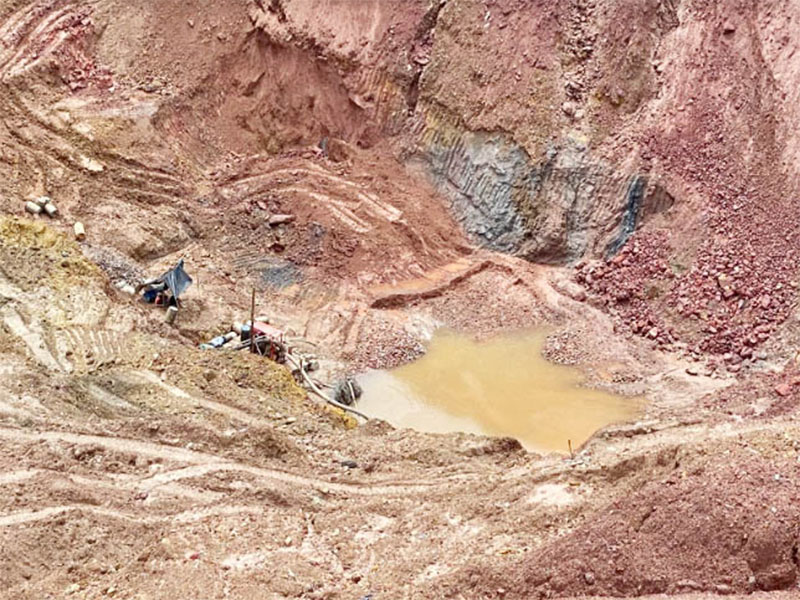The report on the Chinese Landing mining issue has been submitted to the Inter-American Commission on Human Rights (IACHR) and will be published shortly, following an engagement with Minister of Governance and Parliamentary Affairs Gail Teixeira, according to PPP General Secretary Bharrat Jagdeo.
He made this disclosure at a press conference yesterday at Freedom House, Robb Street, Georgetown amid the expressed disappointment by Chinese Landing Toshao Orin Fernandes that their complaint against illegal mining remains unresolved.
“The report has been submitted to the IACHR and will be in the public [domain] shortly, I don’t want to get into the findings of the report, but when it is out you will see exactly its findings on the Chinese Landing issue,” Jagdeo told reporters.
Though the press conference was grounded on the discussion of party matters, the General Secretary said that the Chinese Landing issue is one in which his government would like to see an amicable solution though it is before the courts.
Jagdeo criticised Stabroek News for only highlighting and reporting the negatives which came out of the five-day NTC conference, without referencing significant successes.
In reference to ongoing consultations on the amendment of the Amer-indian Act 2006, the PPP/C General Secretary restated that the process will involve all Indigenous communities.
On July 21, IACHR issued Resolution 41/2023, through which it granted precautionary measures in favour of members of the Indigenous Carib Community of Chinese Landing, who it said are “currently at serious, urgent risk of suffering irreparable harm to their human rights”.
The Commission had asked the government to advise it within 20 days from the ruling as to the steps taken.
A statement from the IACHR said that the petition before it, indicates that the members of Chinese Landing, in Region One, are facing threats, harassment and acts of violence for their opposition to mining activities on their lands. Village representatives alleged repetitive incidents of threats and harassment, which would occur “daily” or “regularly”; advised of acts against persons in particular vulnerability such as aggression to a young man, attempted rape of a minor, and threat with a knife against an elder person; as well as the extensive use of firearms, with firing incidents.
The IACHR noted that Chinese Landing residents have also received collective death threats, reportedly perpetrated by mine workers. For example, it said that the Toshao, who is the leader of the community, was allegedly warned that if the village wins its lands back, the miners would not leave easily and people would die.
The decision of the IACHR had come despite an attempt by the Guyana Government to counter the arguments made by Chinese Landing.
The Chinese Landing impasse was raised at the recent National Toshaos Council Conference which saw the attendance of over 200 Amerindian leaders from villages across the ten administrative regions at the Arthur Chung Conference Centre, at Liliendaal, Georgetown.
The Chinese Landing toshao was granted the opportunity to present his village’s case on day one of the NTC.
With a national stage in the capital city, Fernandes waded into the government at a closed session after President Irfaan Ali had spoken at the opening. He argued that years of inaction by the government had forced Chinese Landing to approach the IACHR. Further, 2021 was the first time that Chinese Landing had initiated legal proceedings against Vieira and the GGMC.
“Our case was thrown out in the High Court without even a hearing and is currently sitting before the Court of Appeal. Our people have been suffering and continue to suffer.
“It is the suffering of our people that caused us to seek redress at the level of the… IACHR. We approached the IACHR on March 8, 2023 seeking precautionary measures to protect us”, Fernandes said.
The IACHR, after analyzing the argument put forward by the community and state, found that that situation deserves a high level of urgency “given the rights to life and personal integrity are at risk.” As such, it called on July 21 for protective measures. Government has since halted all mining activities until further notice.
At the end of its five-day meeting yesterday, the NTC Conference failed to take a stand on illegal mining in the indigenous community of Chinese Landing with the chair of the body stating that the matter was in court.
Background
Chinese Landing is an indigenous Carib Community located on the Barama River with a population of 210 villagers, whose population is predominantly female. The community’s main source of income is from gold mining and livelihoods are sustained through traditional food gathering activities such as hunting, fishing, and farming. Chinese Landing obtained its land title under the Amerindian Act of 1951 (amended in 1976). Further, the title was reissued in 1991 under State Lands Act (1991) under state lands and in 2018, the village received its Certificate of Title pursuant to the Land Registry Act.
On March 8, the IACHR received a request for precautionary measures filed by the Village Council of the Indigenous Carib Community of Chinese Landing, the Amerindian Peoples Association of Guyana and the Forest People’s Programme (on behalf of the members of the Indigenous Carib Community of Chinese Landing). The request called on the Government of Guyana to adopt the necessary steps to protect the health, rights, personal integrity, and life of the people.
This request came as the people of Chinese Landing were contending that Vieira, a concession beneficiary, was given four blocks to mine for gold, but along with his associates, continued to daily harass and threaten villagers.




